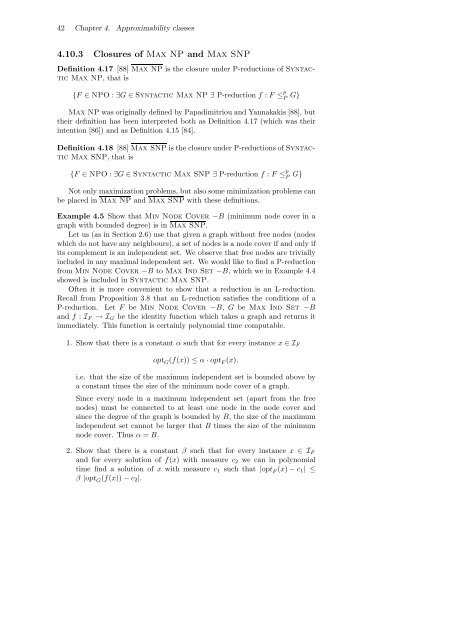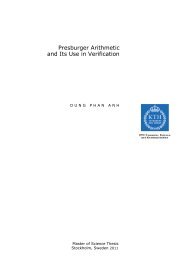On the Approximability of NP-complete Optimization Problems
On the Approximability of NP-complete Optimization Problems
On the Approximability of NP-complete Optimization Problems
You also want an ePaper? Increase the reach of your titles
YUMPU automatically turns print PDFs into web optimized ePapers that Google loves.
42 Chapter 4. <strong>Approximability</strong> classes<br />
4.10.3 Closures <strong>of</strong> Max <strong>NP</strong> and Max S<strong>NP</strong><br />
Definition 4.17 [88] Max <strong>NP</strong> is <strong>the</strong> closure under P-reductions <strong>of</strong> Syntactic<br />
Max <strong>NP</strong>, thatis<br />
{F ∈ <strong>NP</strong>O : ∃G ∈ Syntactic Max <strong>NP</strong> ∃ P-reduction f : F ≤ p<br />
P G}<br />
Max <strong>NP</strong> was originally defined by Papadimitriou and Yannakakis [88], but<br />
<strong>the</strong>ir definition has been interpreted both as Definition 4.17 (which was <strong>the</strong>ir<br />
intention [86]) and as Definition 4.15 [84].<br />
Definition 4.18 [88] Max S<strong>NP</strong> is <strong>the</strong> closure under P-reductions <strong>of</strong> Syntactic<br />
Max S<strong>NP</strong>, thatis<br />
{F ∈ <strong>NP</strong>O : ∃G ∈ Syntactic Max S<strong>NP</strong> ∃ P-reduction f : F ≤ p<br />
P G}<br />
Not only maximization problems, but also some minimization problems can<br />
be placed in Max <strong>NP</strong> and Max S<strong>NP</strong> with <strong>the</strong>se definitions.<br />
Example 4.5 Show that Min Node Cover −B (minimum node cover in a<br />
graph with bounded degree) is in Max S<strong>NP</strong>.<br />
Let us (as in Section 2.6) use that given a graph without free nodes (nodes<br />
which do not have any neighbours), a set <strong>of</strong> nodes is a node cover if and only if<br />
its complement is an independent set. We observe that free nodes are trivially<br />
included in any maximal independent set. We would like to find a P-reduction<br />
from Min Node Cover −B to Max Ind Set −B, which we in Example 4.4<br />
showed is included in Syntactic Max S<strong>NP</strong>.<br />
Often it is more convenient to show that a reduction is an L-reduction.<br />
Recall from Proposition 3.8 that an L-reduction satisfies <strong>the</strong> conditions <strong>of</strong> a<br />
P-reduction. Let F be Min Node Cover −B, G be Max Ind Set −B<br />
and f : IF →IG be <strong>the</strong> identity function which takes a graph and returns it<br />
immediately. This function is certainly polynomial time computable.<br />
1. Show that <strong>the</strong>re is a constant α such that for every instance x ∈IF<br />
opt G(f(x)) ≤ α · opt F (x),<br />
i.e. that <strong>the</strong> size <strong>of</strong> <strong>the</strong> maximum independent set is bounded above by<br />
a constant times <strong>the</strong> size <strong>of</strong> <strong>the</strong> minimum node cover <strong>of</strong> a graph.<br />
Since every node in a maximum independent set (apart from <strong>the</strong> free<br />
nodes) must be connected to at least one node in <strong>the</strong> node cover and<br />
since <strong>the</strong> degree <strong>of</strong> <strong>the</strong> graph is bounded by B, <strong>the</strong> size <strong>of</strong> <strong>the</strong> maximum<br />
independent set cannot be larger that B times <strong>the</strong> size <strong>of</strong> <strong>the</strong> minimum<br />
node cover. Thus α = B.<br />
2. Show that <strong>the</strong>re is a constant β such that for every instance x ∈IF<br />
and for every solution <strong>of</strong> f(x) withmeasurec2 wecaninpolynomial<br />
time find a solution <strong>of</strong> x with measure c1 such that |opt F (x) − c1| ≤<br />
β |opt G(f(x)) − c2|.

















